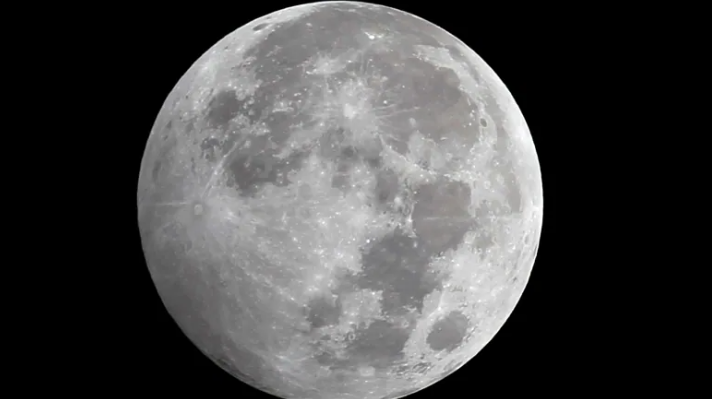How you can watch Mars disappear behind the full moon tonight

How long the event lasts depends on where you are in Canada
If you happen to have clear skies on Wednesday night, you’ll be able to catch a planet disappearing behind the moon.
The event occurs at a special time for Mars. On Wednesday night, Mars will be directly opposite the sun’s position in the sky, rising as the sun sets and setting as the sun rises. This is called an opposition and is when Mars is at its brightest in the night sky.
“Having the moon hide a bright planet is rare,” said Alan Dyer, an amateur astronomer and accomplished astrophotographer who will watch the event from his home near Strathmore, Alta.
“Having it do so on the very night a planet is at its brightest, as Mars now is, is very unusual. And with the objects so well-placed high in our sky. Fabulous!”
When a planet or a star disappears behind another object, it’s called an occultation. The next time this happens between the moon and Mars will be in January 2025, although it will be two days before opposition.
When and where to look
Canada is in a prime location for the event.
Elaina Hyde, director of the Allan I. Carswell Observatory at York University’s department of physics and astronomy in Toronto, is also looking forward to Wednesday night’s occultation.
“Tonight, the occultation of Mars by our moon requires a ‘just right’ alignment,” she said. “In fact, not everyone on Earth will even be able to see this one.”
If you want to watch Mars blink out behind the moon, you just need clear skies. However, binoculars will provide a better view (though, be warned: a full moon is quite bright with binoculars or a telescope).
Because the occultation is between the moon, which is super bright, and Mars, which is at its brightest, they’re easy to find.
All you have to do is look east to find the moon. Mars will appear at the left or lower left, depending on your location.

You can gradually watch the event unfold right after sunset, when the pair will be farther apart. Over the next few hours, the pair will gradually appear to get closer and closer. The moon will seem to move to the left as they rise in the sky, eventually overtaking Mars.
How long Mars will stay eclipsed behind the moon depends on your location: it could be several minutes or about an hour. This is because it depends on how much of the moon’s disc Mars will need to traverse.
For example, in Toronto, Mars will only cross a small fraction of the moon’s lower disc, beginning at 10:29 p.m. ET and re-emerging roughly 45 minutes later. In Edmonton, it will take more than an hour for the entire event.
Here are the approximate times when Mars will disappear behind the moon. All times are local:
- Vancouver: 6:55 p.m.
- Edmonton: 8:04 p.m.
- Calgary: 7:59 p.m.
- Regina: 9:01 p.m.
- Saskatoon: 9:03 p.m.
- Winnipeg: 9:05 p.m.
- Toronto: 10:29 p.m.
- Ottawa: 10:36 p.m.
- Montreal: 10:40 p.m.
- Iqaluit: 9:50 p.m.
- Whitehorse: 8:25 p.m.
- Yellowknife: 8:23 p.m.
Thursday:
- Halifax: 12:15 a.m.
- Charlottetown: 12:07 a.m.
- Moncton: 12:04 a.m.
- St. John’s: 12:25 a.m.
You can find more locations here.
Remember, the event occurs all night, so you can take a peek outside once in a while leading up to the occultation and afterwards as it progresses.
- Stunning images of space abound in this year’s Astronomy Photographer of the Year competition
- James Webb Space Telescope reveals some of the oldest stars in our universe
You may also notice a bright red star not too far away from the moon and Mars, but to the right. That’s Aldebaran, the brightest star in the constellation Taurus.
This red giant lies near one of the most beautiful open star clusters in the northern sky, Hyades. In a few days’ time, once the moon moves away from that area of the sky, try using a pair of binoculars to check out the cluster.
Also, since you’re outside on Wednesday night, why not take a peak to the southwest where Jupiter will be quite apparent as the brightest object in the sky (aside from the moon). A pair of binoculars will also reveal four of its brightest moons, Io, Callisto, Ganymede and Europa.
Related News
Trade war, slumping border traffic: What does that mean for the Gordie Howe bridge?
Amid U.S. President Donald Trump’s tariffs which have triggered a trade war with Canada, cross-border trips haveRead more
Trump administration threatens Harvard’s foreign enrolment, tax-exempt status
U.S. Homeland Security Secretary Kristi Noem speaks during an event on April 9, in Washington,Read more
